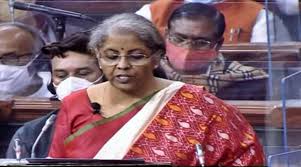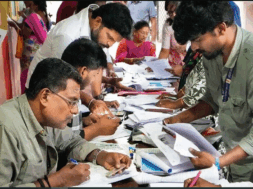
Virendra Pandit
New Delhi: In the 75th year of India’s Independence, Finance Minister Nirmala Sitharaman on Monday unveiled a ‘platinum-coated’ paperless, digital Budget for fiscal 2021-22, providing a major boost to healthcare, infrastructure, and Atmanirbhar Bharat Abhiyan, which made the markets zoom, but she left the income tax slabs unchanged.
Given that the Union Budget 2021-22 came at a time when the Indian economy is reeling under the severe aftereffects of the global pandemic of COVID-19 induced lockdown, the announcements she made in her 110-minute speech, enthused the markets which responded positively: Sensex climbed over 2,300 points and Nifty soared above the 14,250 marks.
The government was aware of the challenges to India’s security.
Sitharaman announced an allocation of Rs 4,78,195.62 crore for the defense sector for 2021-22 as against last year’s Rs 4,71,378 crore (including defense pension). “This is the highest-ever increase in capital outlay for defense in 15 years,” Defence Minister Rajnath Singh said later.
In her speech, the finance minister mentioned that this year’s budget proposals rest on six pillars — health and well-being, physical, financial capital and infrastructure, inclusive development for aspirational India, reinvigorating human capital, innovation, and R and D and Minimum Government and Maximum Governance.
Sitharaman said the government is committed to farmers’ welfare, and added that the MSP regime has undergone a “sea change” to assure price at least 1.5 times of production cost with a sharp increase in procurement of food grains and payment to farmers. Procurement of crops like paddy, wheat, pulses, and cotton has jumped manifold in the last six years, she said, giving comparable statistics.
Over Rs, 75,000 crores were paid to 43.36 lakh wheat farmers in 2020-21.
She proposed an increase in the agriculture credit target to Rs 16.5 lakh crore. The total amount paid to paddy farmers surged to Rs 1.72 lakh crore in 2020-21.
She also highlighted the government’s steps for the welfare of the poor, the migrants, children as well as senior citizens under various schemes. “The announcements made earlier were like 5 mini budgets themselves,” she said.
Recalling Prime Minister Narendra Modi’s launch of the world’s largest vaccination program against COVID-19 on January 16, she said: “Today, India has two vaccines and is not only comforting citizens of her own country but those of neighboring nations too.” More vaccines are on their way.
Sitharaman said the budget for 2021-22 rests on six pillars – from healthcare to infrastructure.
“The total impact of Atmanirbhar Bharat and the measures by RBI was Rs 27.1 lakh crore, which amounts to 30 percent of GDP,” she said.
The government will launch Mission Poshan 2.0 and Jal Jeevan Mission Urban. “The Urban Swachh Bharat scheme will be implemented with an outlay of over Rs 1.4 lakh crore,” she said.
She announced Rs 35,000 crore for the COVID-19 vaccine. “The government is committed to providing more funds. The outlay for health and welfare is Rs 223,846 crore in the 2021-22 Budget. This is a 137 percent increase.”
The Finance Minister said 217 projects worth over Rs 1 lakh crore were completed under the National Infrastructure Pipeline.
She would soon table a bill to essentially fill the gap in long-term finance for infrastructure sectors. Seven ‘Textile Parks’ will be developed in the next three years to boost the sector. The Railways will monetize dedicated fright corridor assets for operations and maintenance after commissioning.
To the thumping of desks, she announced that Rs. 95,000 crores will be spent on the construction of roads in West Bengal which goes to the polls in the next few months.
“For FY22, I propose a sharp increase in capital expenditure at 5.54 lakh crore, up from Rs 4.39 lakh crore in 2021. More economic corridors are being planned to boost road infrastructure.”
The government aims to complete 11,000 km of national highway infrastructure this year. Highway works proposed include 3,500 km corridor in Tamil Nadu, 1,100 km in Kerala at an investment of Rs 65,000 crore, 675 km in West Bengal at a cost of Rs 95,000 crore, and 1,300 km in Assam in the next 3 years.
The Centre aims to spend Rs 1.97 lakh crore on various PLI schemes over the next 5 years, starting this fiscal. This is in addition to the Rs 40,951 crore announced for the PLI for electronic manufacturing schemes.
An outlay of Rs 1.10 lakh crore is earmarked for railways, of which Rs 1.7 lakh crore is for capital expenditure. Also, the Centre will provide Rs 18,000 crore for public buses, she added.
Sitharaman announced Rs 3.05 lakh crore outlay for the power sector and added that 100 more cities will be included in the next 3 years to the gas distribution network, including a new gas pipeline project for Jammu and Kashmir. Leh in Ladakh, she said, will have a Central University.
She earmarked Rs 1,000 crore to solar energy corporation and Rs 1,500 to renewable energy development agency.
The government will support the development of a world-class financial technology hub at Gujarat-based GIFT and an investor charter will be introduced.
Further infusion of Rs 20,000 crore for public sector banks. “The government plans to sell part of its holding in Life Insurance Corporation of India through an initial public offering in the coming year.”
She put disinvestment receipts at Rs 1.75 lakh crore in FY22. Two PSBs and one general insurance company will be divested, and related legislative amendments will be introduced in this session.
“Over 15,000 schools will be qualitatively strengthened under National Education Policy.”
A special scheme for the welfare of women and children in Assam and West Bengal will be introduced and Rs 1,000 crore will be earmarked for West Bengal and Assam tea workers.
The forthcoming Census could be India’s first digital Census, she said, while allocating Rs 3,768 crore for the exercise.
She also announced an allocation of Rs 300 crore to Goa for celebrating the 60th anniversary of its liberation from Portuguese rule.
Introducing some changes to the taxation process, Sitharaman announced the scrapping of income tax for senior citizens under certain conditions, new rules for removal of double taxation for NRIs, and a reduction in the time period of tax assessments among other measures.
Start-ups will get an extension in their tax holiday for an additional year. The advance tax liability on dividend income shall arise after the declaration of payment of dividend. The government will increase the maximum threshold paid-up capital of small companies from Rs 50 lakh to Rs 2 crore and the threshold of maximum turnover from Rs 2 crore to Rs 20 crore.
Some Highlights:
- Fiscal deficit in FY21 to soar up to 9.5% due to a rise in expenditure due to the pandemic and moderation of revenue; fiscal deficit of 6.8% of GDP pegged in FY22.
- The government to borrow about Rs 12 lakh crore in 2021-22. Expenditure for the next fiscal year pegged at Rs 34.83 lakh crore, including Rs 5.54 lakh crore of capital spending.
- Total outlay of around Rs 2 lakh crore on healthcare, with Rs 35,000 crore on COVID-19 vaccine development and inoculation.
- No change in Income Tax slabs this year.
- Introduction of Aatma Nirbhar health program with an outlay of Rs 64,180 crore over six years, in addition to the existing national health mission.
- Main interventions under the PM Aatmanirbhar Swasth Bharat Yojana would include support for health and wellness centers; setting up Integrated Public Health labs in all districts; critical care hospital blocks; strengthening of NCDC.
- Allocation of a record sum of Rs 110,055 crore for Indian Railways to make it future-ready by 2030; of this Rs 107,100 crore reserved for capital expenditure in 2021-22.
- The massive impetus for highways and road transport projects by pumping in Rs 1.03 lakh crores from the government exchequer. The mammoth share allocated to the states which are due for Legislative Assembly elections this year—Tamil Nadu, Kerala, Assam, and West Bengal.
- Further recapitalization of state-owned banks by infusing Rs 20,000 crore in FY22.
- FDI in insurance companies increased from 49 percent to 74 percent, subject to specific compliance.
- LIC to go public; IPO this year.
- BPCL, Air India, Shipping Corporation, Container Corporation, and other disinvestments to be completed in 2021-22.
- Barring four strategic areas, PSUs in other sectors will also be divested under the new disinvestment policy.
- Ujjwala scheme to be expanded to over one crore more beneficiaries. “We will add 100 more districts in the next three years to the city gas distribution network. A gas pipeline project will be taken up in Jammu and Kashmir,” said Sitharaman.
- Reduction of compliance burden on senior citizens who are 75 years of age and above. For senior citizens who only have a pension and interest income, she proposed exemption from filing Income Tax returns.
- Agriculture Infrastructure and Development Cess (AIDC) proposed to be imposed on petrol and diesel at the rate of Rs 2.5 per liter and Rs 4 per liter on diesel.













